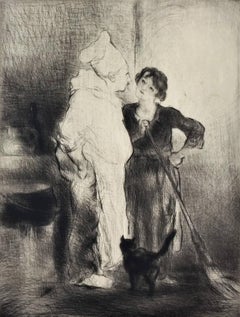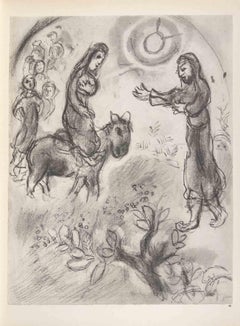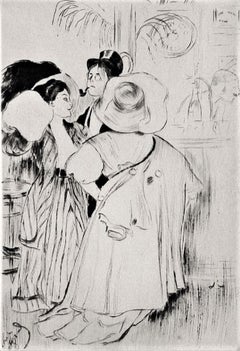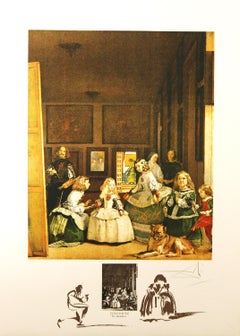Bride Figurative Prints
to
1,011
4,415
1,277
852
277
151
Overall Width
to
Overall Height
to
2,701
924
598
573
163
163
131
75
47
34
16
6
5
313
130
80
70
63
912
1,521
4,115
462
86
161
296
241
232
390
657
807
251
117
757
4,804
2,014
148
27,020
14,813
10,836
9,093
7,854
7,010
4,609
4,217
2,455
2,059
1,936
1,844
1,628
1,459
1,434
1,433
1,408
1,284
1,226
1,109
2,761
2,583
798
501
420
468
3,923
3,506
2,100
Art Subject: Bride
Below Stairs.
Located in Storrs, CT
Below Stairs. 1930-31. Drypoint. Appleby 143. 10 1/4 x 7 3/4 (sheet 15 3/4 x 10 1/8). Edition 100, #31. A very rich, tonal impression on cream-colored laid paper. Unobtrusive soiling in the top left- and lower-left hand margins, just below the platemark; and light mat line just outside the platemark. . Signed and numbered in ink. Housed in a 20 x 16-inch archival mat, suitable for framing. A charming discussion between the chef and a scullery maid in a "Downtown Abbey...
Category
1930s Modern Figurative Prints
Materials
Drypoint, Etching
$975 Sale Price
56% Off
The Return of David - Héliogravure by Marc Chagall - 1960
By Marc Chagall
Located in Roma, IT
Héliogravure on brown-toned paper, no signature.
Héliogravure on bot sheets, recto and verso.
Edition of 6500 unsigned copies. Printed by Mourlot and published by Tériade on the A...
Category
1960s Surrealist Figurative Prints
Materials
Photogravure
English Bar
Located in Storrs, CT
English Bar. 1908. Etching and drypoint. Exsteens catalog 275 state ii. 8 1/8 x 5 5/8 (sheet 17 3/8 x 12 1/4). Series: Les Bars. Edition 65 in this state (total edition 95). Printed ...
Category
Early 1900s Art Nouveau Figurative Prints
Materials
Drypoint, Etching
$800 Sale Price
54% Off
Personages with Lambs
Located in San Francisco, CA
This artwork "Personages with Lambs" 1924 is an original colors aquatint by noted French artist Felix Roy A.K.A Sylvain Sauvage, 1888-1948. It is hand signed and numbered 88/350 in pencil by the artist.
The image size is 13 x 9.5 inches, framed is 20 16 inches. Published and printed by La Societe Des Graveurs Modernes, Paris. Custom framed in a wooden gold frame.
It is in excellent condition, especially considering the age of this artwork
About the artist.
Félix Roy, said Sylvain Sauvage (born in Baume-les-Messieurs ( Jura ) on May 8 , 1888 and died in Paris in January 1948 ) is an illustrator and technician of the French book.
He was an exhibitor at the Salon des Artistes Décorateurs and Director of École Estienne . He illustrated many books of the French classic literature. The work of Sylvain Sauvage is held in numerous private collections in France and Europe.
Selected books illustrated by the artist.
L'Ingénue de Voltaire, Kieffer, 1922
La fille aux yeux d'or de Balzac, G. Crès, 1923
Monsieur Nicolas ou le cœur humain dévoilé. Mémoires intimes de Restif de la Bretonne, illustrés par Sylvain Sauvage de Restif de la Bretonne, Henri Jonquières, 1924
Les Belles Dames de Paris, historiettes de Tallemant de Réaux, coll. « Le livre du lettré », 1924 (avec une préface de Gérard Bauër)
Anatole France, Les sept femmes de la Barbe Bleue et autres contes merveilleux, A.&G. Mornay, Paris, 1925
Marquis de Sade, Ernestine, Cabinet du Livre / Jean Fort Éditeur, Paris, 1926 : 10 eaux-fortes
Casanova (J. de, Seigneur de Seingalt.), Une aventure de Casanova, Histoire complète de ses amours avec la belle C. C. et la religieuse de Muran. Compositions de Sylvain Sauvage gravées avec la collaboration de E. Feltesse. Paris, [chez l'artiste], 1926.
Candide de Voltaire, chez l'Artiste (imprimé chez Frazier-Soye et Haasen), 1928
Les Dieux ont soif de Anatole France, Éditions du Nord, 1928
Le Bon Plaisir d’Henri de Régnier, La Roseraie, 1929 : 20 eaux-fortes en couleurs et vingt bois gravés
La Troisième Jeunesse de madame Prune de Pierre Loti, Calmann-Levy, 1936
Les Romanesques ; Les Deux Pierrots ; La Dernière Nuit de Don Juan d’Edmond Rostand, éditions Pierre Laffitte, 1939 ; illustrations de Auguste Leroux...
Category
Early 20th Century Art Nouveau Figurative Prints
Materials
Aquatint
Velasquez Les Menines by Salvador Dali 1974 Lithograph
Located in Paonia, CO
Velasquez Les Menines is one of six graphics from the series Changes in Great Masterpieces published by Sidney Lucas, 1974. Master Dali has given us a...
Category
1970s Surrealist Figurative Prints
Materials
Lithograph
Opera Garnier : The Ballet - Original lithograph, Mourlot 1969
By Marc Chagall
Located in Paris, IDF
Marc CHAGALL
Opera Garnier : The Ballet, 1969
Original stone lithograph (Printed in Mourlot workshop)
Unsigned and not numbered
On paper 35 x 25 cm (c. 14 x 10 inch)
Edited by XX Si...
Category
1960s Modern Figurative Prints
Materials
Lithograph
Paris Review, Surrealist Modern Lithograph by Robert Kushner
Located in Long Island City, NY
Artist: Robert Kushner, American (1949 - )
Title: Paris Review
Year: 1982
Medium: Lithograph, signed and numbered in pencil
Edition: 200
Size: 30 in. x 44 in. (76.2 cm x 111.76 cm)
Category
1980s Modern Figurative Prints
Materials
Lithograph
Vaso antico che si vede nella Villa di Sua Eminenza Card. Alessandro Albani
Located in Roma, IT
Artist's proof, printed on antique watermarked paper, wide margins, representing an “antique vase in the Villa Albani” as pointed out in the higher note. ...
Category
1770s Old Masters Figurative Prints
Materials
Etching
de La Fresnaye, L'entrée du village, Collection Pierre Lévy (after)
Located in Fairfield, CT
Medium: Lithograph on vélin d'Arches paper
Year: 1968
Paper Size: 20 x 26 inches
Inscription: Signed in the plate and unnumbered, as issued
Notes: From the folio, Roger de la Fresnay...
Category
1960s Cubist Landscape Prints
Materials
Lithograph
$716 Sale Price
20% Off
Gerhard Windisch (1895-1961) - Early 20th Century Etching, Ballet Dancer
Located in Corsham, GB
Signed in plate and signed in graphite. On paper.
Category
20th Century Figurative Prints
Materials
Etching
$245 Sale Price
20% Off
Dufresne, Le Rêve, Dufresne, Collection Pierre Lévy (after)
Located in Fairfield, CT
Medium: Lithograph on vélin d'Arches paper
Year: 1971
Paper Size: 20 x 26 inches
Inscription: Signed in the plate and unnumbered, as issued
Notes: From the folio, Dufresne, VI, Colle...
Category
1970s Post-Impressionist Landscape Prints
Materials
Lithograph
Eventail - Lithograph by Raoul Dufy - 1920
By Raoul Dufy
Located in Roma, IT
Eventail is a vintage lithograph realized by Raul Dufy in the 1920.
Good conditions.
Edition of 110.
The artwork is depicted through confident strokes in a well-balanced composition.
Category
1920s Modern Figurative Prints
Materials
Lithograph
William Shakespeare's "All's Well That Ends Well"after Wheatley- Etching - 1850s
Located in Roma, IT
William Shakespeare's "All's Well That Ends Well" after Wheatley is an etching realized in the 1850s.
Titled and text from play on the lower.
Good conditions with foxing.
This pri...
Category
1850s Modern Figurative Prints
Materials
Etching
Toadstool - Woodcut by Maurits Cornelis Escher - 1931
Located in Roma, IT
Woodcut print realized by Escher for the series "Emblemata", and published in 1931.
On Hollande van Gelder paper.
Edition of 300.
Unsigned, as issued. Excellent condition, matted....
Category
1930s Modern Figurative Prints
Materials
Woodcut
Matisse, Fusain, Dessins de Henri-Matisse (after)
Located in Southampton, NY
Lithograph on vélin Lafuma paper. Unsigned and unnumbered, as issued. Good Condition; never framed or matted. Notes: From the volume, Dessins de Henri-Matisse, 1925. Published by Édi...
Category
1920s Modern Landscape Prints
Materials
Lithograph
$956 Sale Price
20% Off
Imagine a World without Arseholes - Contemporary Art
Located in London, GB
Medium: 1 Colour Screenprint on old reclaimed pages from the Bible with a hand-painted background
Year: 2024
Edition: 40
Paper Size: 31.2cm (h) x 23.5cm (w)
Framed Size: 38.5 (h) x 3...
Category
2010s Street Art Figurative Prints
Materials
Screen
“Marilyn (Head Shot)” Blue Silkscreen Portrait Print on Silver Foil Ed. 47/100
By Bert Stern
Located in Houston, TX
Blue-toned silkscreen portrait print of actress Marilyn Monroe by legendary photographer Bert Stern. The piece features a blue headshot portrait of Marilyn in blue on a metallic silv...
Category
Mid-20th Century Modern Portrait Prints
Materials
Foil
La Paysanne Tournee a Gauche, Les Mains Appuyees L’Une sue L’Autre
Located in Fairlawn, OH
La Paysanne Tournee a Gauche, Les Mains Appuyees L’Une sue L’Autre (Peasant turned left holding her hands)
Etching, 1618
From: Varie Figure (16 plates)
Condition: very good, aging
Im...
Category
1610s Old Masters Figurative Prints
Materials
Etching
Persians - Costumes - Lithograph - 1844
Located in Roma, IT
Persians - Costumes is a Hand-colored lithograph on paper realized in 1862.
The artwork belongs to the Suite Uses and customs of all the peoples of the universe: " History of the g...
Category
1840s Modern Figurative Prints
Materials
Lithograph
A Duel Between Frank and Rashleigh -Lithograph by Richard Parks Bonington - 1828
Located in Roma, IT
A Duel between Frank and Rashleigh is original lithograph on china glued, realized by the artist Richard Parkes Bonington (1802- 1828)
Signed...
Category
1820s Modern Figurative Prints
Materials
Lithograph
Scene Galante au XVIII eme Siecle #2
Located in San Francisco, CA
This artwork titled "Scene Galante au XVIII eme Siecle" c.1930 in an aquatint on paper by French artist Antoine Calbet, 1860-1944. It is hand signed in pencil at the lower right corner. The plate mark (image) size is 9.60 x 12.25 inches, framed size is 16.5 x 19.5 inches. Framed in a wooden gold and black frame, with fabric matting. The artwork is in very good condition, frame and matting are in good condition, frame have some minor dents, matting have a small point of discoloration at upper left.
About the artist.
Antoine Calbet is the son of Marie Singlande and Jean-Baptiste Calbet, landowner at a place called Gaubert.
Trained at the School of Fine Arts in Montpellier by Édouard - Antoine Marsal (1845-1929) where he learned drawing, this illustrator and illustrator, a painter of nudes and gallant scenes, was very popular during his lifetime.
Antoine Calbet is then admitted to the School of Fine Arts in Paris in the studio of Alexandre Cabanel (1823-1889). He was a member of the admission jury of the Beaux-Arts from 1913 to 1930. He began to exhibit in 1880 and became a member of the Society of French Artists . He was the friend of his compatriot of Lot-et-Garonne, the President of the Republic Armand Fallières , for which he drew the menus of his meals, which made him known in Parisian salons.He illustrated works by Jean Lorrain , Henri de Regnier , Pierre Loues 3 and for periodicals like L'Illustration .
Selected museums and collections
Dallas , Dallas Museum of Art : Back woman...
Category
Mid-20th Century Realist Figurative Prints
Materials
Aquatint
Erotic Scene - Héliogravure by Micheal Von Zichy - 1911
Located in Roma, IT
Erotic scene is an original Héliogravure artwork on ivory-colored paper, realized by Micheal Von Zichy in 1911. Printed in only 300 copies, Leipzig; Privatdruck, from the Catalogue ...
Category
1910s Modern Figurative Prints
Materials
Paper, Engraving
Conversation - Lithograph by Adolphe Albert - 20th Century
Located in Roma, IT
Conversation is an original lithograph artwork realized by Adolphe Albert (1855-1938). Signed on the plate,
The state of preservation is very good.
The artwork represents a convers...
Category
20th Century Modern Figurative Prints
Materials
Lithograph
Amicalement - from Rues et Visages de Paris - Drypoint/Etching - 1920s - Modern
By Chas Laborde
Located in Roma, IT
Amicalement is a hand-colored etching and drypoint, signed by Chas Laborde on the lower right margin. Hand-titled on the lower left margin. This original print is hand-colored with t...
Category
1920s Modern Figurative Prints
Materials
Drypoint, Etching, Tempera, Watercolor
Customs - Persian Kings - Lithograph - 1862
Located in Roma, IT
Customs - Persian Kings is a lithograph on paper realized in 1862.
Titled on the lower.
The artwork belongs to the Suite Uses and customs of all the peoples of the universe: " Hist...
Category
1860s Modern Figurative Prints
Materials
Lithograph
Girl with Unicorn, Lithograph by Gina 'Jennie' Tomao Stephanopoulos
Located in Long Island City, NY
Girl with Unicorn
Gina ’Jennie’ Tomao Stephanopoulos, American (1934–2011)
Date: circa 1979
Lithograph, signed and numbered in pencil
Edition of 300
Image...
Category
1970s Figurative Prints
Materials
Lithograph
Homage to Michelangelo - Original Etching by Jorge Castillo - 1975
Located in Roma, IT
Homage to Michelangelo is an original artwork realized by Jorge Castillo in 1975.
Black and white etching.
Hand signed and dated on the lower margin.
Numbered on the lower left. E...
Category
1970s Contemporary Figurative Prints
Materials
Etching
Untitled (Mirror)
By Leonor Fini
Located in Columbia, MO
Untitled (Mirror)
1976
Serigraph
Ed. Edition of 175
25.75 x 20.5 inches
Category
1970s Surrealist Figurative Prints
Materials
Screen
Les Pavots Noirs - Phototype after Odilon Redon - 1923
By Odilon Redon
Located in Roma, IT
Les Pavots Noirs is a phototype reproduction realized after Odilon Redon.
They belong to the suite "Odilon Redon Peintre, Dessinateur et Graveur", published by Henri Felury in 1923...
Category
1920s Symbolist Figurative Prints
Materials
Photogravure
Signac, St-Paul-de-Vence, Signac Dessins (after)
By Paul Signac
Located in Fairfield, CT
Medium: Lithograph on vélin de Lana paper
Year: 1950
Paper Size: 9.75 x 12.5 inches
Inscription: Unsigned and unnumbered, as issued
Notes: From the album, Signac Dessins, 1950. Publi...
Category
1950s Post-Impressionist Landscape Prints
Materials
Lithograph
$716 Sale Price
20% Off
Phantasy
Located in Santa Monica, CA
CARL HOECKNER (1883 – 1972)
PHANTASY c 1935 Lithograph edition unknown, but rare. Slight glue stain
upper margin. 10 ½” x 15 ¾” ...
Category
1930s Surrealist Figurative Prints
Materials
Lithograph
$750 Sale Price
23% Off
Dante's Repetance - Plate n. 30 Purgatory - WoodcutPrint - 1963
Located in Roma, IT
Dante's Repetance from the Series "The Divine Comedy" - Plate n. 30 Purgatory is a woodcut print realized in 1963 for a series illustrating the Medieval poem of the "Divine Comedy" ...
Category
1960s Surrealist Figurative Prints
Materials
Woodcut
Gerlach's Allegorien Plate #114: "Vignettes" Lithograph by Carl Otto Czeschka
Located in Chicago, IL
after Carl Otto Czeschka, (1878-1960), Austrian
A leading member of the Vienna Secession and later the Wiener Werkstätte (Viennese Workshop), Carl Otto Czeschka was a vital figu...
Category
1890s Vienna Secession Figurative Prints
Materials
Lithograph
Max Eisler Eine Nachlese folio “Adam & Eve” collotype print
Located in Chicago, IL
After Gustav Klimt, Max Eisler #20, Adam und Eva; multi-color collotype after unfinished 1917/18 painting in oil on canvas.
GUSTAV KLIMT EINE NACHLESE (GUSTAV KLIMT AN AFTERMATH), a...
Category
1930s Vienna Secession Figurative Prints
Materials
Paper
"Le Peintre et son Modèle" - Original Lithograph
Located in Collonge Bellerive, Geneve, CH
Original Lithograph - Pablo Picasso
"Le Peintre et son Modèle" - Original Lithograph from "Picasso Lithographe IV"
Dimensions: 32 x 25 cm
1964...
Category
1960s Modern Figurative Prints
Materials
Lithograph
Les Pavots Noirs - after Odilon Redon - 1923
By Odilon Redon
Located in Roma, IT
Les Pavots Noirs is a prototype reproduction realized after Odilon Redon.
They belong to the suite "Odilon Redon Peintre, Dessinateur et Graveur", published by Henri Felury in 1923....
Category
1920s Symbolist Figurative Prints
Materials
Photogravure
Divina Commedia - Héliogravure by Franz von Bayros - Early 20th Century
Located in Roma, IT
"Divina Commedia" is an original Black and white héliogravure on cream-colored cardboard realized by Choisy Le Conin, pseudonym of Franz Von Bayros (A...
Category
Early 20th Century Symbolist Figurative Prints
Materials
Engraving
The Suffering Folk - Original Etching by Louis Jou - Early 20th Century
By Louis Jou
Located in Roma, IT
The Suffering Folk is an original etching realized by Louis Jou in the Early 20th Century.
Applied on a Passpartout by gluing: 47 x 63 cm.
Hand-Signed, Numbered. Edition, 14/40.
Good conditions.
Louis Jou (Gracia, 1882 - Baux, 1968), the twentieth-century etcher and wood engraver, was a prolific illustrator of a large number of books in France, authored by big names like Andre Gide...
Category
1920s Modern Nude Prints
Materials
Etching
Figures - Etching by Marcello Avenali - Late 20th Century
Located in Roma, IT
Figures is an original etching on paper by Marcello Avenali.
Hand-signed.
Numbered, edition 125/125. Image Dimensions: 32 x 50 cm
Very good condition except for worn margins.
Mar...
Category
Late 20th Century Contemporary Figurative Prints
Materials
Etching
Cherub - Héliogravure by Marc Chagall - 1960
By Marc Chagall
Located in Roma, IT
Héliogravure on brown-toned paper, so signature.
On bot sheets, recto and verso.
Edition of 6500 unsigned copies. Printed by Mourlot and published by Tériade, Paris.
Ref. Mourlot,...
Category
1960s Surrealist Figurative Prints
Materials
Photogravure
"Le Passant, " Original Color Lithograph
Located in Milwaukee, WI
"Le Passant" is an original Art Nouveau color lithograph. It depicts two women in the foreground wearing medieval white robes and a knight passing behind them on a black horse. Features the L'Estampe Moderne blindstamp bottom right hand corner. 1898.
15 3/4" x 12" art
23" x 19 1/4" framed
Robert Engels studied in Dusseldorf and moved shortly thereafter to work in Munich. Later, he became a professor at a school of applied arts at the KGS in Munich. He created many decorative prints as well as stained glass windows and also created compositions to illustrate Joseph Bedier's rendition of "Tristan and Iseult...
Category
1890s Art Nouveau Figurative Prints
Materials
Lithograph
Venus zeigt Amor Psyche - Etching by Max Klinger - 1880
By Max Klinger
Located in Roma, IT
Etching and aquatint realized in 1880, belonging to the Series "Amor und Psyche", Opus V.
Ref. Singer 67, IV.
Excellent condition.
Category
1880s Symbolist Figurative Prints
Materials
Etching
Machpela Cave Chevron 1969 Israeli Judaica Lithograph Baruch Nachshon Chabad Art
Located in Surfside, FL
Baruch Nachshon, was born in Mandatory Palestine in 1939, in the city of Haifa.
Nachshon began to paint in early childhood, and developed his relationship to art and to artists throu...
Category
1960s Modern Interior Prints
Materials
Lithograph
The Beach - Surrealism Belgian
By Paul Delvaux
Located in London, GB
This original lithograph in colour is hand signed by the artist in pencil "P. Delvaux" at the lower right margin.
It is also inscribed in pencil “H.C.” an Hors Commerce [out of trade...
Category
1970s Surrealist Figurative Prints
Materials
Lithograph
Peace Buddha. Signed Limited Edition Print
By Sax Berlin
Located in Brecon, Powys
Limited Edition Giclee print of Sax Berlin's original painting Peace Buddha.
Original size
Edition of 50. Signed by artist and printer comes with certificate of authentication. On ...
Category
2010s Contemporary Figurative Prints
Materials
Giclée
Crucifixion
Located in Fairlawn, OH
Jean Pichore workshop, 1500-1541
Crucifixion
Metal cut engraving printed on vellum with vintage hand coloring
c. 1500-1541
Miniature (image) size: 4 3/4 x 3 1/8"
Including decorated ...
Category
16th Century Old Masters Figurative Prints
Materials
Engraving
Bullfight - Lithograph by José Guevara - 20th Century
Located in Roma, IT
Bullfight is an artwork realized by Josè Guevara in the 20th century.
Colored lithograph on paper. Edited by Fondazione Di Paolo.
Hand-signed in penci...
Category
Late 20th Century Contemporary Figurative Prints
Materials
Lithograph
The Young Woman and the Old Man - Héliogravure by Marc Chagall - 1960
By Marc Chagall
Located in Roma, IT
Héliogravure on brown-toned paper, so signature.
On bot sheets, recto and verso.
Edition of 6500 unsigned copies. Printed by Mourlot and published by Tériade, Paris.
Ref. Mourlot,...
Category
1960s Surrealist Figurative Prints
Materials
Photogravure
The Radiant Prince Genji - Woodcut Print by Utagawa Kunisada - 1850s
Located in Roma, IT
Plate from Faithful Images of the Radiant Prince Genji is an original modern artwork realized by Utagawa Kunisada in 1850s.
Woodcut print Oban yokoe format.
From the series "Sono...
Category
19th Century Modern Figurative Prints
Materials
Woodcut
The Cherub - Héliogravure by Marc Chagall - 1960
By Marc Chagall
Located in Roma, IT
Héliogravure on brown-toned paper, no signature.
Héliogravure on bot sheets, recto and verso.
Edition of 6500 unsigned copies. Printed by Mourlot and published by Tériade on the A...
Category
1960s Surrealist Figurative Prints
Materials
Photogravure
Toulouse-Lautrec, Composition, TLautrec (after)
Located in Fairfield, CT
Medium: Lithograph and stencil on vélin paper
Year: 1946
Paper Size: 17 x 13 inches
Inscription: Signed in the plate and unnumbered, as issued
Notes: From the folio, TLautrec, 1946. ...
Category
1940s Post-Impressionist Figurative Prints
Materials
Lithograph
$716 Sale Price
20% Off
Kollwitz, Working-Class Woman with Sleeping Child (after)
Located in Southampton, NY
Lithograph on vélin paper. Inscription: Unsigned and unnumbered, as issued. Good condition. Notes: From the folio, Kathe Kollwitz, Ten Lithographs. Published by Henry C. Kleemann and...
Category
1940s Modern Landscape Prints
Materials
Lithograph
$1,436 Sale Price
20% Off
Suk - Chromolithograph after Karl Werner - 1881
Located in Roma, IT
Suk is a modern artwork realized d'apres Karl Werner
Mixed colored Chromolithograph.
The artwork is after the watercolor realized by the artist during a trip to Egypt between 18...
Category
1880s Modern Figurative Prints
Materials
Lithograph
Washing Day, Modern Lithograph by Jean Jansem
By Jean Jansem
Located in Long Island City, NY
Artist: Jean Jansem, French (1920 - )
Title: Washing Day
Year: circa 1970
Medium: Lithograph, signed and numbered in pencil
Edition: EA
Image Size: 17 x 23 inches
Paper Size: 19 x 2...
Category
1960s Modern Figurative Prints
Materials
Lithograph
Jesus and the Disciples - Original Woodcut print by François Bouchot - 1922
Located in Roma, IT
Jesus and the Disciples is an Original woodcut print realized by François Bouchot in 1922.
The artwork is in good condition and included a brown cardboard passpartout (36.5x27.5 cm).
No signature.
François Bouchot (1800-1842), peintre et graveur, est né à Paris en 1800. Il étudia la gravure sous la direction de Richomme, puis devint élève de Regnault, puis de Lethière, et obtint le grand prix...
Category
1920s Modern Figurative Prints
Materials
Woodcut
Persian Cloth in 19th Century- Lithograph - 1862
Located in Roma, IT
Persian Cloth in 19th Century is a Hand-colored lithograph on paper realized in 1862.
The artwork belongs to the Suite Uses and customs of all the peoples of the universe: " History...
Category
1860s Modern Figurative Prints
Materials
Lithograph
Art Nouveau Muse - Lithograph (Les Maîtres de l'Affiche), Imprimerie Chaix 1900
Located in Paris, IDF
Henri PRIVAT-LIVEMONT (1861-1936)
Art Nouveau Muse, 1900
Original lithograph
Printed signature in the plate
On vellum
Size 39 x 29 cm (c. 15.3 x 11.4")
INFORMATION : Plate 212 of ...
Category
1890s Art Nouveau Figurative Prints
Materials
Lithograph
Journal Des Demoiselles - Original Lithograph by Paul Lacourière - 19th Century
Located in Roma, IT
Plate from Journal Des Demoiselles is an original artwork realized in the 19th century by Paul Lacourière
Mixed colored lithograph from the Le...
Category
19th Century Modern Figurative Prints
Materials
Lithograph
Black Passion
Located in Fairlawn, OH
Black Passion
Aluminum plate lithograph from two plates, 1975
Signed, titled and numbered in pencil by the artist
Edition 50
Published at Lakeside Studio with the Master printer Jack Lemon
Imagery depicts the Seven deadly Sins three Roman soldiers and Simon of Cyrene, who was forced to help Christ carry the cross
One of Pozzatti's favorite works
Condition: Otherwise very good condition Soft rippling bottom margin
Image size: 20 x 28 inches (50.80 x 71.12cm)
Sheet size: 24 x 32 inches
"Painter and printmaker Rudolph Otto "Rudy" Pozzatti was born in Telluride, Colorado, on January 14, 1925. Upon graduation from high school, he received a scholarship to attend the University of Colorado in Boulder where he enrolled as an art major. In 1943, his studies were interrupted by his induction into the U. S. Army. After his discharge in 1946, he re-enrolled in the University of Colorado where he studied under Wendell...
Category
1970s American Modern Figurative Prints
Materials
Lithograph
Joshua Reads the Word of the Law (Pencil Signed)
Located in Missouri, MO
Signed in Pencil Lower Right "Marc Chagall"
Numbered Lower Left 77/275
Image Size: approx. 11 3/4 x 9 1/4 inches
Framed Size: approx. 24 x 21 inches
Category
1950s Impressionist Figurative Prints
Materials
Lithograph



